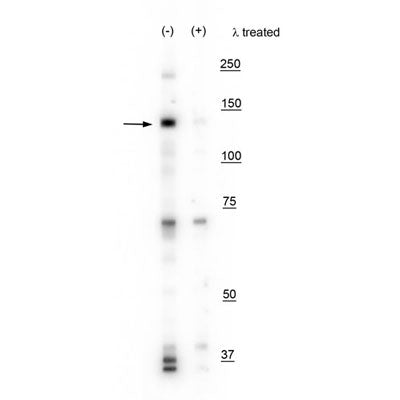Anti-IRE1 (Ser724) Antibody
Our Anti-IRE1 (Ser724) rabbit polyclonal phosphospecific primary antibody from PhosphoSolutions is p
- SPECIFICATION
- CITATIONS
- PROTOCOLS
- BACKGROUND

| Primary Accession | Q9EQY0 |
|---|---|
| Host | Rabbit |
| Clonality | Polyclonal |
| Isotype | IgG |
| Calculated MW | 110185 Da |
| Gene ID | 78943 |
|---|---|
| Other Names | Endoplasmic reticulum (ER) to nucleus signalling 1 antibody, Endoplasmic reticulum to nucleus signaling 1 antibody, Endoplasmic reticulum-to-nucleus signaling 1 antibody, Endoribonuclease antibody, ER to nucleus signaling 1 antibody, ERN 1 antibody, Ern1 antibody, ERN1_HUMAN antibody, hIRE 1p antibody, hIRE1p antibody, Inositol requiring 1 antibody, Inositol requiring 1, S. cerevisiae, homolog of antibody, Inositol requiring enzyme 1, S. cerevisiae, homolog of antibody, Inositol requiring protein 1 antibody, inositol-requiring enzyme 1 antibody, Inositol-requiring protein 1 antibody, IRE 1 antibody, IRE 1a antibody, IRE 1P antibody, Ire1 alpha antibody, Ire1-alpha antibody, IRE1a antibody, Ire1alpha antibody, IRE1P antibody, MGC163277 antibody, MGC163279 antibody, Protein kinase/endoribonuclease antibody, RGD1559716 antibody, Serine/threonine protein kinase/endoribonuclease IRE1 antibody |
| Target/Specificity | IRE1, inositol requiring 1 protein, is an ER transmembrane sensor that activates unfolded protein response (UPR) to maintain the ER and cellular function (Chen et al, 2013). The activation of UPR involves three signaling pathways, IRE1, PERK, and ATF6, which are crucial to returning protein homoeostasis to levels of non-stressed cells (Stewart et al, 2012). Changes in ER homeostasis causing unfolded protein buildup can be due to Ca2+ depletion, hypoxia, altered glycosylation, and viral infection triggering the UPR and activation of IRE1 (Stewart et al, 2012). UPR dysfunction plays an important role in the pathogenesis of neurodegenerative diseases including Alzheimer's disease, Parkinson's disease, amyotrophic lateral sclerosis and Huntington's disease, which is characterized by the accumulation and aggregation of misfolded proteins (Xiang C et al, 2017). The phosphorylation of IRE1 at ser724 may play a significant role in understanding these diseases. |
| Format | Antigen Affinity Purified from Pooled Serum |
| Storage | Maintain refrigerated at 2-8°C for up to 6 months. For long term storage store at -20°C in small aliquots to prevent freeze-thaw cycles. |
| Precautions | Anti-IRE1 (Ser724) Antibody is for research use only and not for use in diagnostic or therapeutic procedures. |
| Shipping | Blue Ice |

Thousands of laboratories across the world have published research that depended on the performance of antibodies from Abcepta to advance their research. Check out links to articles that cite our products in major peer-reviewed journals, organized by research category.
info@abcepta.com, and receive a free "I Love Antibodies" mug.
Provided below are standard protocols that you may find useful for product applications.
Background
IRE1, inositol requiring 1 protein, is an ER transmembrane sensor that activates unfolded protein response (UPR) to maintain the ER and cellular function (Chen et al, 2013). The activation of UPR involves three signaling pathways, IRE1, PERK, and ATF6, which are crucial to returning protein homoeostasis to levels of non-stressed cells (Stewart et al, 2012). Changes in ER homeostasis causing unfolded protein buildup can be due to Ca2+ depletion, hypoxia, altered glycosylation, and viral infection triggering the UPR and activation of IRE1 (Stewart et al, 2012). UPR dysfunction plays an important role in the pathogenesis of neurodegenerative diseases including Alzheimer's disease, Parkinson's disease, amyotrophic lateral sclerosis and Huntington's disease, which is characterized by the accumulation and aggregation of misfolded proteins (Xiang C et al, 2017). The phosphorylation of IRE1 at ser724 may play a significant role in understanding these diseases.
If you have used an Abcepta product and would like to share how it has performed, please click on the "Submit Review" button and provide the requested information. Our staff will examine and post your review and contact you if needed.
If you have any additional inquiries please email technical services at tech@abcepta.com.













 Foundational characteristics of cancer include proliferation, angiogenesis, migration, evasion of apoptosis, and cellular immortality. Find key markers for these cellular processes and antibodies to detect them.
Foundational characteristics of cancer include proliferation, angiogenesis, migration, evasion of apoptosis, and cellular immortality. Find key markers for these cellular processes and antibodies to detect them. The SUMOplot™ Analysis Program predicts and scores sumoylation sites in your protein. SUMOylation is a post-translational modification involved in various cellular processes, such as nuclear-cytosolic transport, transcriptional regulation, apoptosis, protein stability, response to stress, and progression through the cell cycle.
The SUMOplot™ Analysis Program predicts and scores sumoylation sites in your protein. SUMOylation is a post-translational modification involved in various cellular processes, such as nuclear-cytosolic transport, transcriptional regulation, apoptosis, protein stability, response to stress, and progression through the cell cycle. The Autophagy Receptor Motif Plotter predicts and scores autophagy receptor binding sites in your protein. Identifying proteins connected to this pathway is critical to understanding the role of autophagy in physiological as well as pathological processes such as development, differentiation, neurodegenerative diseases, stress, infection, and cancer.
The Autophagy Receptor Motif Plotter predicts and scores autophagy receptor binding sites in your protein. Identifying proteins connected to this pathway is critical to understanding the role of autophagy in physiological as well as pathological processes such as development, differentiation, neurodegenerative diseases, stress, infection, and cancer.


